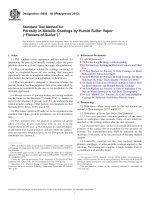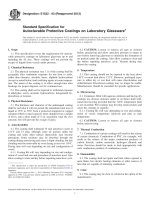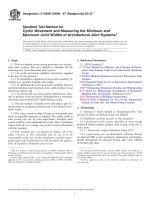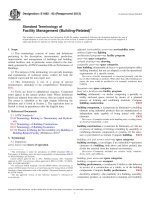Astm e 1034 95 (2013)
Bạn đang xem bản rút gọn của tài liệu. Xem và tải ngay bản đầy đủ của tài liệu tại đây (88.52 KB, 5 trang )
Designation: E1034 − 95 (Reapproved 2013)
Standard Specification for
Nuclear Facility Transient Worker Records1
This standard is issued under the fixed designation E1034; the number immediately following the designation indicates the year of
original adoption or, in the case of revision, the year of last revision. A number in parentheses indicates the year of last reapproval. A
superscript epsilon (´) indicates an editorial change since the last revision or reapproval.
INTRODUCTION
There is a high degree of concern in the nuclear industry regarding the ability of present records
keeping practices to adequately monitor the cumulative radiation doses of individual transient
workers. This concern arises from the fact that the transient worker moves rapidly among the nuclear
facilities, in some cases working at as many as four or more facilities within one calendar quarter. The
accurate monitoring of a transient worker’s cumulative radiation dose depends, in part, on the
individual worker’s ability (and willingness) to provide a correct record of his occupational radiation
exposure. At nuclear facilities licensed by the U.S. Nuclear Regulatory Commission (NRC), these data
presently are supplied by the worker on forms NRC-4 and NRC-5. Similar procedures are followed
at other nuclear facilities (see Note 1). Accurate occupational radiation exposure data are required to
ensure that the radiation doses that an individual transient worker will receive are within regulatory
limits.
Another problem confronting the owners of nuclear facilities is how to in-process large numbers of
temporary workers efficiently. These workers may be required for such activities as the decontamination and decommissioning of a nuclear facility, the annual refueling of a nuclear power plant, or a
major special modification to an operating nuclear facility. In-processing involves determining a
worker’s occupational radiation exposure history, security clearance, health status, ability to wear and
use respiratory protective equipment, and training and qualification for work in controlled areas.
In-processing is the responsibility of the licensee, and depends on the cooperation of the worker and
the worker’s present and past employers and other past contracting licensees.
In-processing is complicated by the fact that different facilities keep the required information on
different forms in varying degrees of detail. In-processing one worker often can take several days and
result in a loss of productive time as well as increased staffing costs for the facility operator.
One possible solution to these problems is a cooperative effort within the nuclear industry to
develop a common or central data base that can be accessed to obtain pertinent historical data on a
worker. A central record keeping system (CRS) is envisioned for this purpose. Such a system could
help reduce in-processing time for temporary workers.
However, some degree of standardization is necessary before a centralized record keeping system
is possible. This specification standardizes the necessary content of transient worker records.
1. Scope
1.2 This specification applies to records to be used for
in-processing only.
1.1 This specification covers the required content and provides retention requirements for records needed for inprocessing of nuclear facility transient workers.
1.3 This specification is not intended to cover specific skills
records (such as equipment operating licenses, ASME inspection qualifications, or welding certifications).
1.4 This specification does not reduce any regulatory requirement for records retention at a licensed nuclear facility.
1
This specification is under the jurisdiction of ASTM Committee E10 on
Nuclear Technology and Applicationsand is the direct responsibility of Subcommittee E10.03 on Radiological Protection for Decontamination and Decommissioning
of Nuclear Facilities and Components.
Current edition approved Jan. 1, 2013. Published January 2013. Last previous
edition approved in 2008 as E1034-95(2008). DOI: 10.1520/E1034-95R13.
NOTE 1—Nuclear facilities operated by the U.S. Department of Energy
(DOE) are not licensed by the U.S. Nuclear Regulatory Commission
(NRC), nor are other nuclear facilities that may come under the control of
Copyright © ASTM International, 100 Barr Harbor Drive, PO Box C700, West Conshohocken, PA 19428-2959. United States
1
E1034 − 95 (2013)
3.1.3 committed effective dose equivalent (CEDE), n—the
sum of the committed dose equivalents to various tissues in the
body, each multiplied by its weighting factor. It does not
include contributions from external dose.
3.1.4 controlled area, n—an area of a nuclear facility
encompassed by physical barriers to which access is controlled.
3.1.4.1 Discussion—This definition is equivalent to the
restricted area definition for NRC and Agreement State Licensees. It is not the same as the controlled area definition with
which NRC and Agreement State Licensees are familiar.
3.1.5 deep dose equivalent (DDE), n—dose equivalent delivered to tissue at a depth of 1.0 cm or more from the surface.
3.1.6 dose equivalent (H), n—the product of D, Q, and N, at
the point of interest in tissue, where D is the absorbed dose, Q
is the quality factor, and N is the product of any other
modifying factors.
3.1.6.1 Discussion—The SI unit of dose equivalent is the
sievert (equal to 1 J/kg). The traditional unit of dose equivalent
is the rem. One Sv = 100 rem.
3.1.7 employer, n—a person or concern that employs persons for wages or salary. Note that a worker may have more
than one employer at a given time.
3.1.8 estimated dose, n—dose data supplied by the licensee
to the worker prior to the determination of the official record
dose (see section 10CFR Part 19 or equivalent).
3.1.8.1 Discussion—Estimated doses are provided at the
worker’s request and generally when the worker is terminating
a work assignment involving radiation exposure at a licensee’s
facility.
3.1.9 external dose equivalent, n—dose equivalent due to
radiation sources located outside the body.
3.1.10 extremity, n—hands and arms below the elbow or feet
and legs below the knee (see 3.1.23).
3.1.11 extremity dose, n—the external (shallow/deep) dose
to the extremities.
3.1.12 eye dose equivalent, n—dose equivalent to the lens of
the eye from external radiation sources is taken as the dose
equivalent at a tissue depth of 0.3 cm (300 mg/cm2).
3.1.13 in-processing, n—the determination, prior to starting
work, of a worker’s previous occupational radiation exposure
history, security clearance, health status, ability to wear and use
respiratory and other personal protective equipment, and training and qualification for work in controlled areas.
3.1.14 nuclear facility, n—a facility whose operations involve (or involved) radioactive materials in such form and
quantity that a nuclear hazard potentially exists (or existed) to
the employees and the general public. Included are facilities
that are (or were) used to produce, process, or store radioactive
materials (see Note 1). Some examples are: nuclear reactor
(power or research), fuel fabrication plant, fuel reprocessing
plant, uranium or thorium mill, UF6 production plant, radiochemical laboratory, and radioactive waste disposal site.
3.1.15 occupational radiation exposure, n— radiation exposure resulting from, and received in, the course of an individual’s employment.
the U.S. Department of Defense (DOD) or individual agreement states.
The references in this specification to licensee, the U.S. NRC Regulatory
Guides, and Title 10 of the U.S. Code of Federal Regulations are to imply
appropriate alternative nomenclature with respect to DOE, DOD, or
agreement state nuclear facilities. This distinction does not alter the
required content of records needed for in-processing of nuclear facility
transient workers.
NOTE 2—This specification does not define the form of the required
worker records (such as a passport or central computerized record keeping
system).
2. Referenced Documents
2.1 ASTM Standards:2
E1168 Guide for Radiological Protection Training for
Nuclear Facility Workers
2.2 ANSI Standards:
ANSI N13.6 American National Standard Practice for Occupational Radiation Exposure Records Systems3
2.3 Nuclear Regulatory Commission Documents:
Regulatory Guide 8.7, Instructions for Recording and Reporting Occupational Radiation Exposure Data4
Regulatory Guide 8.15, Acceptable Programs for Respiratory Protection4
NUREG/CR-0041, Manual of Respiratory Protection
Against Airborne Radioactive Materials4
2.4 CFR Documents:
Notices, Instructions, and Reports to Workers; Inspections,
10CFR, Part 194
Standards for Protection Against Radiation, 10CFR, Part 204
2.5 American Nuclear Insurers Documents:
ANI/MAELU Information Bulletin 80-1A, Nuclear Liability
Insurance Records Retention5
3. Terminology
3.1 Definitions of Terms Specific to This Standard:
3.1.1 absorbed dose(D), n—for purposes of records maintained in accordance with this specification, absorbed dose is
the energy absorbed per unit mass at a specific place in a
material.
3.1.1.1 Discussion—The SI unit of absorbed dose is the gray
(Gy), equal to 1 J/kg (10,000 ergs/g). The traditional unit of
absorbed dose is the rad. One Gy = 100 rad. As used in this
specification, “absorbed dose” stands for the absorbed dose in
soft tissue.
3.1.2 committed dose equivalent (CDE), n— dose equivalent to organs or tissues of reference that will be received from
an intake of radioactive material by an individual during the
50-year period following the intake.
2
For referenced ASTM standards, visit the ASTM website, www.astm.org, or
contact ASTM Customer Service at For Annual Book of ASTM
Standards volume information, refer to the standard’s Document Summary page on
the ASTM website.
3
Available from American National Standards Institute (ANSI), 25 W. 43rd St.,
4th Floor, New York, NY 10036, ..
4
Available from the Superintendent of Documents, U.S. Government Printing
Office, Washington, DC 20402.
5
Available from American Nuclear Insurers, 95 Glasterburg Boulevard, Suite
300, Glasterburg, CT 06033-453.
2
E1034 − 95 (2013)
5. Content of Nuclear Facility Transient Worker
Records—
3.1.16 offıcial record dose, n—dose data supplied by the
licensee to the worker and the NRC in accordance with
10CFR20.2206 (or equivalent).
5.1 The following format for recording dates to facilitate
entry into electronic information systems is recommended:
DDAAAYYYY (day—2 digits; month—3 alphabetic; year—4
digits).
3.1.17 radiation, n—in the context of this specification,
“radiation” refers to ionizing radiation. Ionizing radiation is
any electromagnetic or particulate radiation capable of producing ions, directly or indirectly, by interaction with matter.
5.2 Worker Identification Data Element:
5.2.1 Name—last, first, and middle initial, as applicable.
5.2.2 Identification code (such as a social security number
or passport number).
5.2.3 Date of birth.
5.2.4 Permanent address.
5.2.5 Verification that the data contained in the worker’s
record have been reviewed by the worker and are complete to
the best of the worker’s knowledge as of the verification date.
5.2.6 Date of verification.
3.1.18 radiation exposure, n—in the context of this
specification, “exposure” refers very broadly to the act or state
of being irradiated by ionizing radiation.
3.1.19 shallow dose equivalent (SDE), n— dose equivalent
delivered to the skin or an extremity at a tissue depth of 0.007
cm (7 mg/cm2) averaged over an area of 1 square centimeter.
3.1.19.1 Discussion—DOE reporting requirements in 10
CFR 835.205 include provisions for assessing nonuniform
exposures of the skin from X-rays, beta radiation, or radioactive materials on the skin, or a combination thereof. This
assessment addresses affected skin areas of: ≥ 100 cm2, < 100
cm2 but ≥ 10 cm2, and < 10 cm2 with provisions for recording
each.
5.3 Occupational External Radiation Exposure Data Elements:
5.3.1 Current calendar year occupational external radiation
exposure data element shall include the following information
for each employer during the current calendar year (see Note
3):
5.3.1.1 Name of employer,
5.3.1.2 Address of employer,
5.3.1.3 Period of exposure (from - to),
5.3.1.4 Name and address of nuclear facility for the period
of exposure (see 5.3.1.3),
5.3.1.5 Deep dose equivalent for the period of exposure (see
5.3.1.3),
5.3.1.6 Shallow dose equivalent for the skin of the whole
body for the period of exposure (see 5.3.1.3 and 3.1.19),
5.3.1.7 Shallow dose equivalent for the skin of the extremity
receiving the maximum dose for the period of exposure (see
5.3.1.3, 3.1.19, and 3.1.23),
5.3.1.8 Eye dose equivalent to the lens of the eye for the
period of exposure (see 5.3.1.3), and
5.3.1.9 Total effective dose equivalent for the period of
exposure (see 5.3.1.3).
5.3.1.10 For each of the doses identified in 5.3.1.5-5.3.1.9,
specify whether the entry is an official record dose or an
estimated dose.
5.3.2 At the end of the current calendar year the whole body
dose information will be transferred to the lifetime radiation
exposure history data element (see 5.5).
3.1.20 total effective dose equivalent (TEDE), n—the sum of
the deep dose equivalent (for external exposures) and the
committed effective dose equivalent (for internal exposures).
3.1.21 transient worker, n—a worker who has work assignments at two or more different nuclear facilities within one
calendar year. This may or may not involve a change in
employer.
3.1.22 vital area, n—an area of a nuclear facility that
contains any equipment, system, or device, the failure or
destruction of which could directly or indirectly endanger
public health and safety by exposure to radiation.
3.1.23 whole body dose, n—includes the external deep dose
to the head and trunk, active blood-forming organs, including
gonads, and the elbows and arms above the elbow, or the knees
and legs above the knee.
3.1.23.1 Discussion—The NRC (10CFR20.1003) includes
the knees and elbows with the extremities.
4. Significance and Use
4.1 The standardization of nuclear facility transient worker
records will provide the individual transient worker with a
greater assurance that the radiation doses that may be received
are within regulatory limits.
4.2 This specification establishes a fixed content for nuclear
facility transient worker records. Standardizing the content of
these records will facilitate interfacing with industry-wide
record keeping systems, such as the Nuclear Energy Institute
(NEI) Personnel Data System (PADS).
NOTE 3—The amount of worker external radiation exposure data that is
kept on file at a nuclear facility greatly exceeds that required by data
element 5.3.1 (for example, radiation type, dosimeter type, or dosimeter
location on the body (see ANSI N13.6). This level of detail is not,
however, required for records to be used for in-processing of transient
workers.
4.3 The standardization of nuclear facility transient worker
records will reduce the time required for in-processing of these
workers.
5.4 Occupational Internal Radiation Exposure Data Element:
3
E1034 − 95 (2013)
5.4.1 The committed dose equivalent (CDE) shall be determined for each organ affected by a radiation source located
inside the body.
5.4.2 Data should be recorded to assist in the dose determination and should include, as a minimum, the following:
5.4.2.1 Radionuclide,
5.4.2.2 Inhalation class (if applicable),
5.4.2.3 Mode of intake,
5.4.2.4 Intake amount,
5.4.2.5 Date of intake, if known, and
5.4.2.6 Form of radionuclide (for example, oxide, metal,
etc.).
5.6 Security Screening Data Element:
5.6.1 Statement that the worker has or has not been screened
for unescorted access to a nuclear facility (yes or no),
5.6.2 Date of security screening, and
5.6.3 Location of security screening records, including
name and address of contact for auditing purposes.
5.7 Medical Approval Data Element:
5.7.1 Statement that the worker has or has not received a
respirator use medical examination (yes or no),
5.7.2 Statement that the worker is or is not medically
approved to use a respirator per NRC Regulatory Guide 8.15
and NUREG-0041 (yes or no),
5.7.3 Date of last medical evaluation for respirator use. A
physician must determine that a worker is physically able to
use respiratory protective equipment prior to the initial use of
a respirator and either every 12 months thereafter or periodically at a frequency determined by a physician that the
individual is medically fit (see paragraph 20.1703(a)(3)(v) of
10CFR Part 20) (see Note 6),
5.7.4 Name and title of person providing medical approval
for respirator use, and
5.7.5 Location of medical evaluation records including
name and address of contact for auditing purposes.
5.5 Lifetime Occupational Radiation Exposure History
Data Element—The data element shall include the following
information for each employee (see Note 4 and Note 5):
5.5.1 Name of employer,
5.5.2 Address of employer,
5.5.3 Period of exposure (from - to),
5.5.4 Name and address of nuclear facility for the period of
exposure (see 5.5.3),
5.5.5 Deep dose equivalent (DDE) for the period of exposure (see 5.5.3). For the deep dose equivalent, specify whether
the entry is an official record dose or an estimated dose,
5.5.6 Shallow dose equivalent to the skin of the whole body
for the period of exposure (see 5.5.3),
5.5.7 Shallow dose equivalent to the skin of the extremity
receiving the maximum dose for the period of exposure (see
5.5.3),
5.5.8 Eye dose equivalent to the lens of the eye for the
period of exposure (see 5.5.3),
5.5.9 Committed dose equivalent (CDE) for the maximally
exposed organ during the period of exposure (see 5.5.3),
5.5.10 Committed effective dose equivalent (CEDE) for all
internal exposures received during the period of exposure (see
5.5.3),
5.5.11 Total organ dose equivalent (TODE), which is the
sum of deep dose equivalent (DDE) and committed dose
equivalent (CDE), and
5.5.12 Total effective dose equivalent (TEDE), which is the
sum of deep dose equivalent (DDE) and committed effective
dose equivalent (CEDE).
NOTE 6—The medical evaluation records must include a physician’s
signed statement that the worker is or is not medically approved to use a
respirator.
5.8 Radiation Worker Training Data Element:
5.8.1 Statement that the worker has or has not satisfactorily
completed a radiation worker training program (see Guide
E1168),
5.8.2 Date of radiation worker training, and
5.8.3 Location of training records, including name and
address of contact for auditing purposes.
6. Retention of Nuclear Facility Transient Worker
Records
6.1 Records referenced in 5.2 through 5.8.3 may be beneficial in future defense litigation. Legal counsel of the employer,
licensee, or insured, or combination thereof, should be consulted for determination of records retention periods.
6.2 Guidance provided in ANSI N13.6 and ANI/MAELU
Information Bulletin 80-1A will assist in establishing appropriate records retention requirements.
NOTE 4—At both NRC licensed nuclear facilities and at DOE facilities,
a worker is permitted to receive planned special exposure(s) in addition to
the annual limits, provided the planned special exposure(s) would not
cause an individual to receive additional doses in excess of applicable
annual limits. The NRC further restricts such planned special exposures
during the individual’s lifetime. Records of the doses from planned special
exposures shall be maintained in the individual’s occupational exposure
file.
NOTE 5—The information identified in 5.5 is not all of the information
required on form NRC-4.
7. Keywords
7.1 exposure history; in-processing data; personnel radiation worker data; radiation exposure; radiation worker; records
retention; transient worker
4
E1034 − 95 (2013)
ASTM International takes no position respecting the validity of any patent rights asserted in connection with any item mentioned
in this standard. Users of this standard are expressly advised that determination of the validity of any such patent rights, and the risk
of infringement of such rights, are entirely their own responsibility.
This standard is subject to revision at any time by the responsible technical committee and must be reviewed every five years and
if not revised, either reapproved or withdrawn. Your comments are invited either for revision of this standard or for additional standards
and should be addressed to ASTM International Headquarters. Your comments will receive careful consideration at a meeting of the
responsible technical committee, which you may attend. If you feel that your comments have not received a fair hearing you should
make your views known to the ASTM Committee on Standards, at the address shown below.
This standard is copyrighted by ASTM International, 100 Barr Harbor Drive, PO Box C700, West Conshohocken, PA 19428-2959,
United States. Individual reprints (single or multiple copies) of this standard may be obtained by contacting ASTM at the above
address or at 610-832-9585 (phone), 610-832-9555 (fax), or (e-mail); or through the ASTM website
(www.astm.org). Permission rights to photocopy the standard may also be secured from the ASTM website (www.astm.org/
COPYRIGHT/).
5









